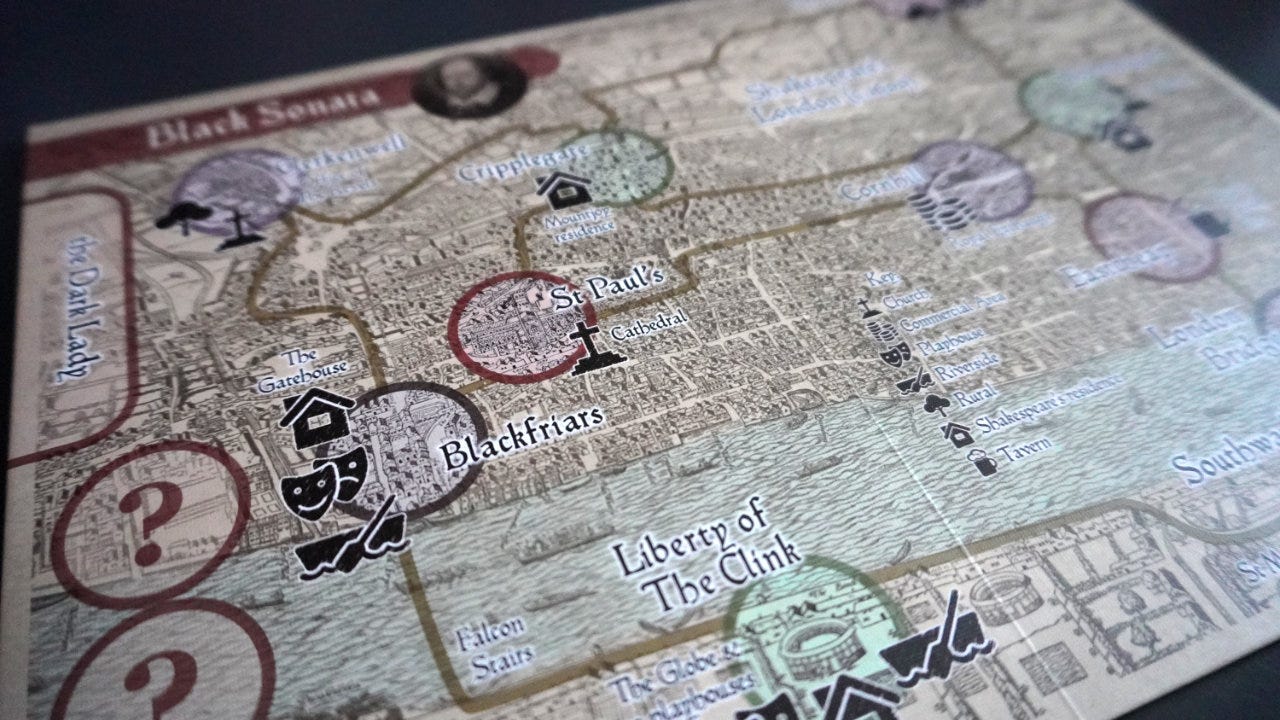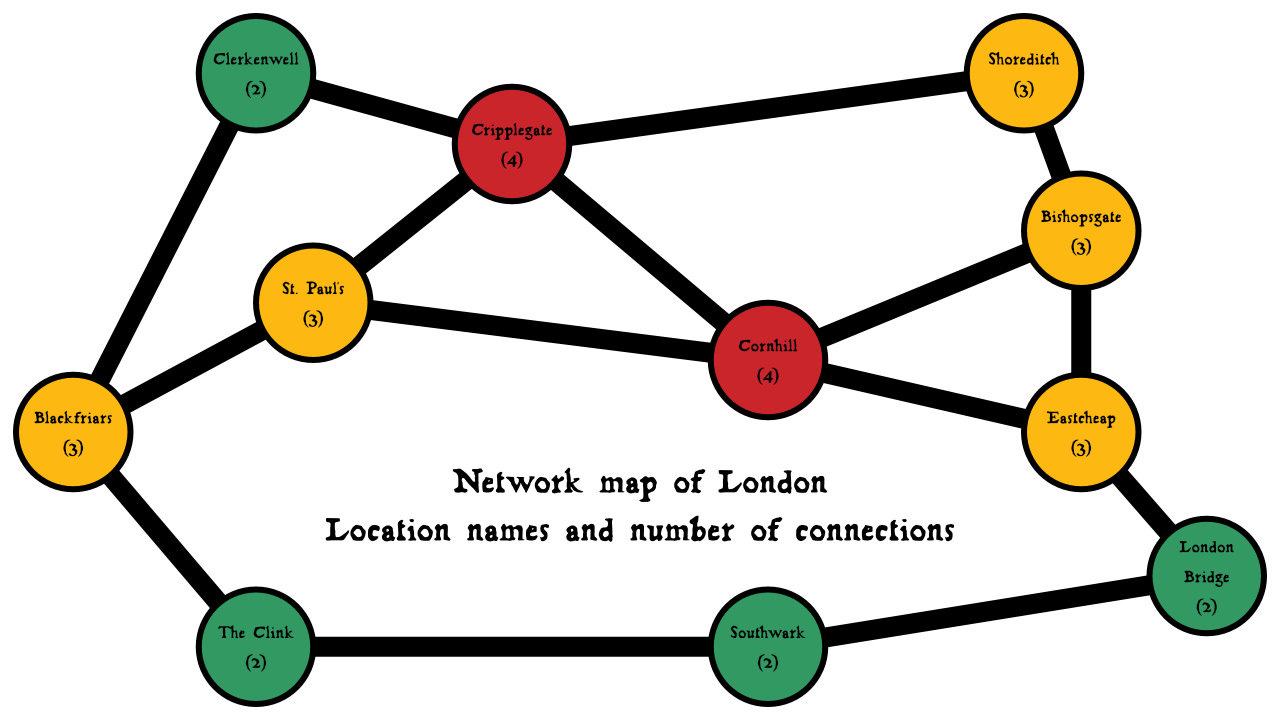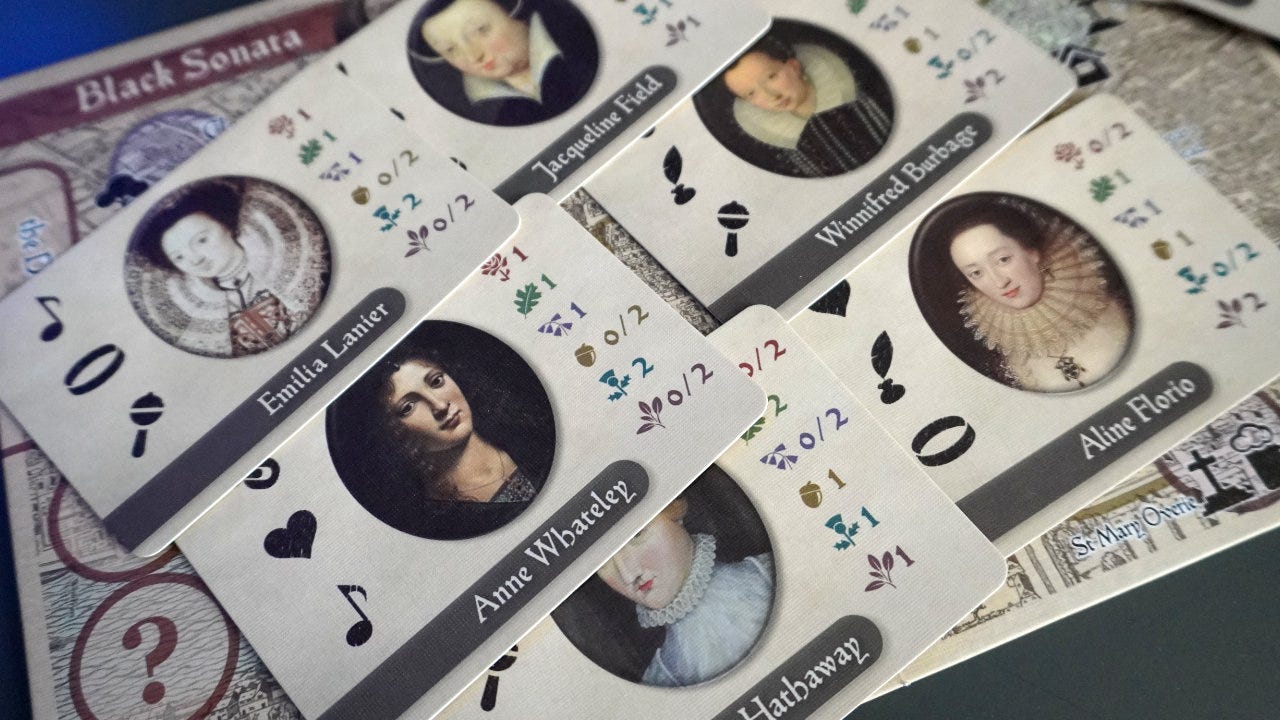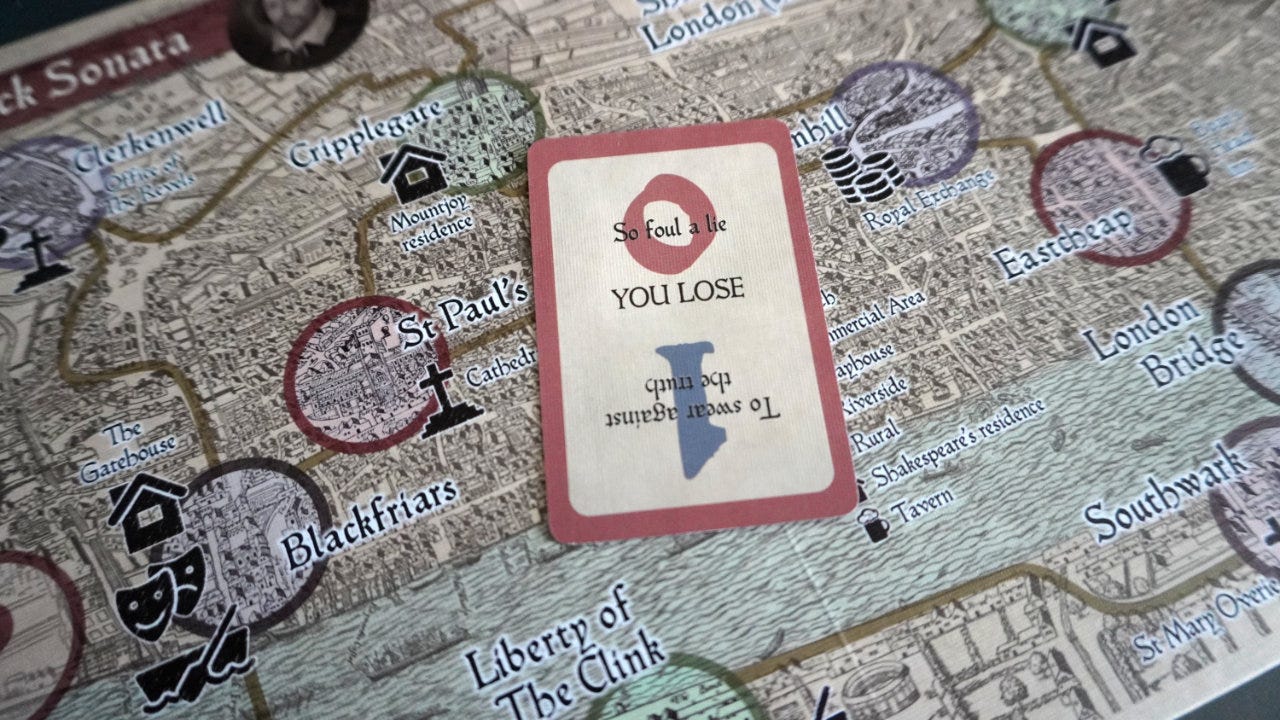Will you confront the Dark Lady?
Exploring the challenges of designing a solo hidden movement deduction game via Black Sonata.
Welcome to Skeleton Code Machine, an ENNIE-nominated and award-winning weekly publication that explores tabletop game mechanisms. Check out Public Domain Art and Fragile Games to get started. Subscribe to TUMULUS to get more design inspiration delivered to your door each quarter!
Last week we looked at Lacksmith, a one-page RPG. If you’d like to make your own one-page roleplaying game, I have a guide that will help you do it.
This week we are exploring solo deduction games — specifically Black Sonata.
Black Sonata
Black Sonata (Kean, 2017) is a solo deduction game about Shakespeare’s London:
For more than four centuries scholars have argued over the identity of the mysterious Dark Lady of William Shakespeare's sonnets. According to the sonnets, the Dark Lady seduced the poet and held him in an agonized thrall while also conducting an affair with the Fair Youth whom Shakespeare also loved. In Black Sonata you will find yourself in Shakespeare's London, circa 1600, in pursuit of the shadowy Lady.
Using a deck of cards to control the Dark Lady’s movement around eleven London locations, you’ll attempt to catch her. Each time you catch a glimpse of her, you’ll gain another clue to her identity. Gather enough clues to identify her, make your guess, and confront her at your current location.1 Guess correctly and win. Guess incorrectly and lose the game.
It’s a relatively small and quick game, playing in about 30 minutes. The elegance and cleverness of the design, however, has me thinking about it long after I played.
Solo design challenges
In hidden movement games like Beast (Midhall, Midhall, et al., 2023) and Sniper Elite: The Board Game (Tankersley & Thompson, 2022), one of the players is actively maintaining a record of movement during the game, ensuring that all moves are legal. This presents some unique challenges, as I noted in the Hunter vs. Hunted: Hidden Movement Games article, including hidden player mistakes and maintaining traceable paths.2 Both are solvable problems, of course, but the solutions typically require one of the players to act as the keeper of the hidden information. They are the one who maintains the hidden, traceable path.
The core challenge of solo deduction game design is the lack of a designated player who maintains the hidden information. There is no one to check and ensure that all moves are legal, nor is there anyone to keep a traceable record of movement.
How is it possible to design a solo, hidden movement deduction game?
The path of the Dark Lady
In Black Sonata, there is no player to perform the hidden movement tasks so the game needs to handle it mechanically.
The elegant solution to this is by using a deck of “stealth cards” that have eight letters (4 top, 4 bottom) and a single, black silhouette of a lady. These cards create the path the lady will take, ensuring all moves are legal. They also are used when attempting to catch her at a location.
During game setup, the cards are arranged in alphabetical order using one set of letters on the card. For example, you can use the top leftmost letters on all cards, arranging them A…Z in order.3
Each round the Lady’s location is updated by taking the top card and placing it on the bottom of the deck, maintaining the original ordering. The symbol on the back of the card (showing) is a hint at where she might be. If it is a mug of beer, she must be at a location with that matching symbol: Eastcheap or Southwark. If the symbol is a cross, she must be at Clerkenwell, Bishopsgate, or St. Paul’s.
This continues each round with her moving from location to location. They key is that, due to the order of the deck, she will always move to a connected location. She will never skip a location, allowing her position to be deduced.
An example path around London
We can reduce the game board map to a simple network diagram:
Then, using the top leftmost letters on the cards, create a path for the Lady through the city — 26 cards/locations in total. The first card (A) has the silouette in the bottom-right position, indicating Eastcheap — her starting location. The next card (B) the silhouette is in the top-left position for Bishopsgate. The next card (C) the silhouette is in the bottom-left position for Cornhill.
All of these are legal moves to connected locations and never skip a location.
The next image could be considered a minor spoiler, but your memory would need to be way better than mine for that to be the case. Feel free to skip if you have a photographic memory.
We can then map out the entire A…Z route (blue line):
It’s interesting to look at this path and note some of the higher frequency location. She only passes through St. Paul’s once, but spends quite a bit of time in Cornhill, Bishopsgate, and Eastcheap.
Presumably each letter combination on the stealth cards would create a completely different route.
Deducing the Dark Lady’s location
The next clever thing in Black Sonata is how players search for the Lady. Again, because there is no player with knowledge of her location, you can’t just ask as you would in other hidden movement games. Instead you a use a location key card that contains a small, circular hole. When placed over the current stealth card, if the silhouette is visible, you found the Lady! If it is not visible, she is not there.
This works because each location key card has a hole with a fixed position. The silhouettes used for her position (explained above) are all tied to a specific location. For example, the bottom-left silhouette position is always Cornhill. This connection never changes.
We can take all 11 location key cards and trace them out to see how the silhouettes are arranged:
Once again, a fascinating way to maintain hidden information while allowing the player to check if they guessed correctly or not! Plus it uses the same deck of cards that control her movement.
This is not a rules explanation
While this applies to every Skeleton Code Machine article, I feel the need to reiterate that this is not intended to be a rules explanation or “how to play” tutorial. There is a lot more going on with Black Sonata than explained here. The clue deck, deduction tokens, and way that you ultimately guess the Lady’s identity (not just location) is just as interesting. There are also fog cards that are added to the deck each time you attempt a search at a location.
Check out the Black Sonata review by Liz Davidson for a more thorough explanation.
Conclusion
Some things to think about:
Always something new to learn: I’ve played a lot of board games and quite a few TTRPGs, but I’d never be so foolish as to think I’ve seen everything. I continue to be surprised and amazed by innovative design ideas. Black Sonata is a truly fascinating example of this.
Custom components help: The size and feel of Black Sonata makes it seem like it could have lived a different life as an indie TTRPG zine game. In fact, it began as a print and play game. The challenge would be to implement this core premise without custom components. The custom printed (and hole punched) cards seem like a necessity.
Reduce maps to network diagrams: I love the thematic London map used in Black Sonata, and used a similar point-crawl map in Eleventh Beast. When designing and testing a game like this, it can be helpful to strip the theme away. The map becomes a set of interconnected nodes.
What do you think? What solo deduction games have you played and enjoyed? Do you think a game similar to Black Sonata could be made without requiring custom components?
— E.P. 💀
P.S. It’s March! Tumulus Issue 2 will begin shipping soon. There are a limited number of Tumulus Issue 1 back issues available. Once they are gone, they are gone! Subscribe so you don’t miss any in the future.
Skeleton Code Machine is a production of Exeunt Press. All previous posts are in the Archive on the web. Subscribe to TUMULUS to get more design inspiration. If you want to see what else is happening at Exeunt Press, check out the Exeunt Omnes newsletter.
It would seem that the scholarly consensus is that the Dark Lady was not a real, historical person. It’s still a really fun theme for a game.
Hunter vs. Hunted was one of the “best of” articles selected for print in the second issue of Tumulus. It fit in well with the “Keep the wolves at bay.” theme.
For replayability, any of the eight letter positions (i.e. combinations) can be used to “seed” or setup the game. They can also be reversed (i.e. Z…A) rather than alphabetical. This creates at least 16 different paths the lady can take, which is far too many to memorize even when playing the game repeatedly. Even so, there are still more sequences available in the back of the rulebook.












Can we just talk about the clever and elegant mechanic of the location key cards revealing the silhouette (or not). So smart!
In Mathematics there is this concept of graph theory, which also talks about network diagrams like these. Did you study any of that?
I wonder if they used any of that theory in their game design.
The concept of the game is also really interesting. I really enjoyed playing scotland yard as a kid so I might pick this up.